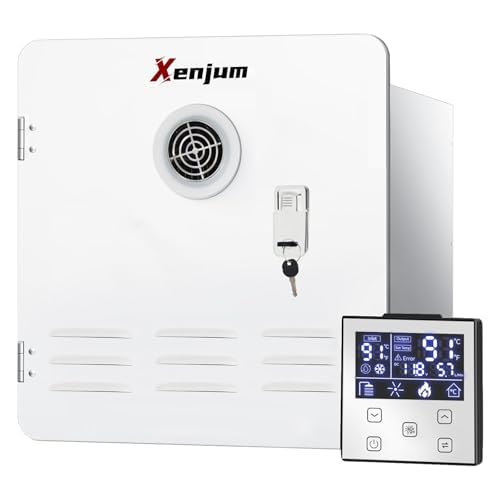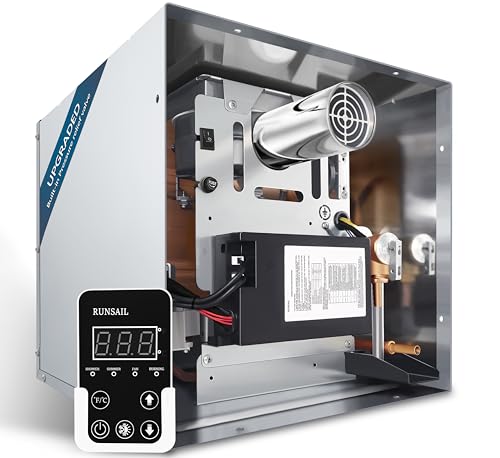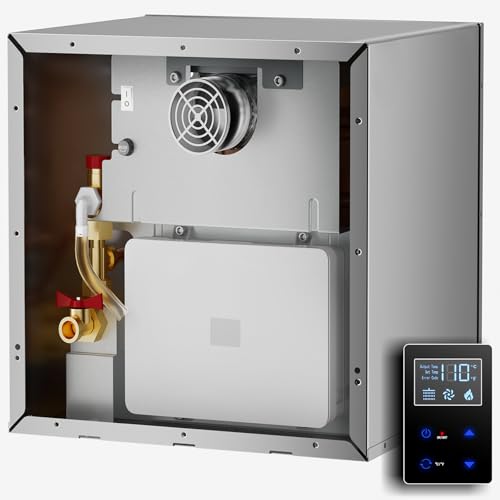This guide compares top 65,000 BTU propane tankless water heaters suitable for RVs, camper vans, and small off-grid dwellings. Below is a quick comparison table of selected models to help you scan key features before reading full product sections.
| Product | Peak Output | GPM | Notable Feature |
|---|---|---|---|
| KINGRVER 65,000 BTU RV Tankless | 65,000 BTU | Low-pressure activation 0.5 GPM | High-altitude operation, multiple door sizes |
| Xenjum 65,000 BTU Tankless | 65,000 BTU | Up to 3.9 GPM | Dual outlets, shower kit included |
| RUNSAIL 65,000 BTU Tankless | 65,000 BTU | Up to 3.96 GPM | Built-in pressure relief valve, safety focus |
| CAMPLUX Climatech 65,000 BTU | 65,000 BTU | Max 2.64 GPM | Compact indoor design, ±1°F control |
| Poukaran 65,000 BTU Tankless | 65,000 BTU | Noted for steady flow | Oxygen-free copper heat exchanger, freeze protection |
Content Navigation
- KINGRVER 65,000 BTU RV Tankless Water Heater
- Xenjum 65,000 BTU Tankless RV Water Heater
- RUNSAIL 65,000 BTU Tankless RV Water Heater
- CAMPLUX Climatech 65,000 BTU Propane Tankless
- Poukaran 65,000 BTU RV Tankless Water Heater
- Ranein 65,000 BTU RV Tankless Water Heater
- Hillhub 65,000 BTU RV Tankless Water Heater
- Buying Guide: How To Choose A 65,000 BTU Propane Tankless RV Water Heater
KINGRVER 65,000 BTU RV Tankless Water Heater

The KINGRVER RV tankless heater provides a 65,000 BTU output with a standout 0.5 GPM low-pressure activation, which helps start heating when water pressure is minimal. It lists compatibility with standard RV openings and offers optional exterior door kits in three sizes (15″x15″, 15″x18″, 18″x18″) for refitment.
Designed for high-altitude operation, the unit claims reliable performance above 9,800 feet and includes automatic freeze protection below 42.8°F. Those features are relevant for users camping at elevation or in cold conditions. The product targets RV retrofit scenarios where door size flexibility and low-pressure activation are priorities.
Xenjum 65,000 BTU Tankless RV Water Heater

Xenjum’s model offers 65,000 BTU output and specifies up to 3.9 GPM, supporting continuous hot water for multiple uses. The listing emphasizes endless hot water on demand, which is typical of tankless designs and useful for back-to-back showers or simultaneous tasks.
Call 888-896-7031 for Free Local HVAC Quotes – Compare and Save Today!
Notable hardware includes dual water outlets for front and rear connections, and a shower kit included, making it ready for both indoor and outdoor use. Temperature adjustment is available from 95°F to 124°F with thermostatic control for steady output. The package suits RV users who want a complete install-ready option with flexible water access points.
RUNSAIL 65,000 BTU Tankless RV Water Heater

RUNSAIL’s 65,000 BTU tankless unit highlights safety and reliability. It integrates a built-in pressure relief valve that meets ANSI & CSA standards to reduce the need for external relief valve installation and to avoid frequent drips or unwanted pressure releases.
The model supports up to 3.96 GPM and positions itself as an on-demand solution that can provide continuous hot water when gas and water supply are adequate. The seller emphasizes improved waterway pressure capacity and design features intended to extend equipment life. This model is relevant when compliance and an integrated relief valve are important for installation simplicity and code alignment.
CAMPLUX Climatech 65,000 BTU Propane Tankless

CAMPLUX Climatech delivers 65,000 BTU with a listed max flow of 2.64 GPM, suited to one- or two-point water uses in small living spaces. The unit is described as an indoor installation option with a compact form factor favored for tight spaces such as tiny homes or mobile apartments.
Call 888-896-7031 for Free Local HVAC Quotes – Compare and Save Today!
The model emphasizes precision tempering with ±1°F control via advanced flow sensors and a smart chip. This level of temperature stability benefits users seeking consistent comfort at a lower maximum flow rate. The compact design may be prioritized when space and indoor mounting are decisive factors.
Poukaran 65,000 BTU RV Tankless Water Heater

Poukaran’s unit lists 65,000 BTU and highlights continuous hot water delivery with a brushless DC fan and an oxygen-free copper heat exchanger to promote efficient heat transfer. The listing notes compatibility with standard RV openings and optional door sizes for retrofit flexibility.
The product emphasizes segmented combustion to control temperature and high-altitude capability, along with freeze protection. These technical features can be appealing when durability, efficiency, and operation in varied climates are priorities for RV owners and full-timers.
Ranein 65,000 BTU RV Tankless Water Heater

Ranein’s 65,000 BTU heater includes a thermostatic chamber and a multi-function controller with an upgraded remote that monitors gas usage, voltage, and flow rate. Real-time metrics aim to help users optimize energy use during long trips.
The model advertises energy savings by running only when water is demanded and positions itself for reliable performance in cold weather. The monitoring features may be useful for those tracking resource consumption while living or traveling off-grid.
Hillhub 65,000 BTU RV Tankless Water Heater

Hillhub promotes 3-second heating and a 3.9 GPM stable flow, along with ±1°F temperature control. The listing indicates anti-corrosion housing and a compact form built for RV plumbing systems.
For users prioritizing rapid response time and steady flow for showers and cleaning tasks, this model targets space-constrained RV installations with materials chosen for longevity in mobile environments.
Buying Guide: How To Choose A 65,000 BTU Propane Tankless RV Water Heater
Selecting the right 65,000 BTU tankless propane heater requires balancing flow, installation constraints, safety features, and environmental conditions. Below are the essential considerations and comparison perspectives.
Tips for Getting the Best HVAC Prices
- Prioritize Quality Over Cost
The most critical factor in any HVAC project is the quality of the installation. Don’t compromise on contractor expertise just to save money. - Check for Rebates
Always research current rebates and incentives — they can significantly reduce your overall cost. - Compare Multiple Quotes
Request at least three estimates before making your choice. You can click here to get three free quotes from local professionals. These quotes include available rebates and tax credits and automatically exclude unqualified contractors. - Negotiate Smartly
Once you've chosen a contractor, use the proven strategies from our guide — How Homeowners Can Negotiate with HVAC Dealers — to get the best possible final price.
Flow Rate (GPM) And Real-World Use
- GPM Ratings: Flow rates determine how many water fixtures can run simultaneously. 2–3 GPM supports a single shower; 3.5–4 GPM supports multiple points or higher flow showers.
- Water Pressure: Many RV systems have limited water pressure. Models with low-pressure activation or good low-start characteristics are useful when city hookups or pumps provide weak pressure.
Heat Output Versus Efficiency
- 65,000 BTU: All items here list 65,000 BTU, but actual performance depends on heat exchanger design and combustion efficiency.
- Heat Exchanger Materials: Copper or oxygen-free copper heat exchangers often increase transfer efficiency and durability.
- Combustion Control: Segmented or staged combustion can prevent overheating and improve efficiency across seasons.
Installation And Physical Fit
- Door Size Compatibility: Confirm the exterior access door size and whether door kits are available for retrofit installations.
- Indoor vs Outdoor Mounting: Some units are designed for indoor installation with proper venting; others mount externally on the RV wall.
- Integrated vs External Components: Models with integrated relief valves or included shower kits reduce accessory purchases and simplify installs.
Altitude, Climate, And Freeze Protection
- High-Altitude Operation: Look for units rated for high-altitude use if you camp at elevation; combustion and air/fuel ratios can be affected at altitude.
- Freeze Protection: Automatic freeze protection or built-in measures are key for cold-weather travel to prevent pipe and exchanger damage.
Safety And Code Compliance
- Pressure Relief Valve: Built-in relief valves meeting ANSI/CSA standards reduce extra hardware and potential leak points.
- Certifications: CSA, ANSI, or other recognized certifications indicate that a model meets regulated safety benchmarks. Verify requirements for your region.
Controls, Monitoring, And Comfort
- Thermostatic Control: Precise temperature control (±1°F claims) improves shower comfort and reduces temperature swings.
- Remote Monitoring: Remote controllers that display gas usage, voltage, and GPM can help manage fuel and electrical resources on long trips.
Durability, Materials, And Maintenance
- Heat Exchanger Longevity: Copper or oxygen-free copper exchangers often require less maintenance and resist corrosion.
- Fan Types: Brushless DC fans can increase service life and reduce electrical draw.
- Service Access: Check how easy it is to access components for cleaning, anode checks (if present), or repairs.
Comparison Perspectives
- RV Full-Timers: Prioritize freeze protection, high-altitude performance, integrated safety components, and monitoring features to manage resources.
- Weekend Campers: Consider plug-and-play kits that include shower accessories and dual outlets for outdoor convenience.
- Small Space Installations: Choose compact indoor-rated units with stable temperature control and lower max GPM if only one fixture is needed.
Practical Tips Before Purchase
- Measure your existing opening and verify door kit availability or replacement door sizes for retrofit.
- Confirm gas supply capacity and regulator compatibility for 65,000 BTU operation.
- Check local codes for venting and indoor installation requirements when mounting inside the RV or cabin.
- Allocate time for professional installation if you are not experienced with gas and venting systems.
